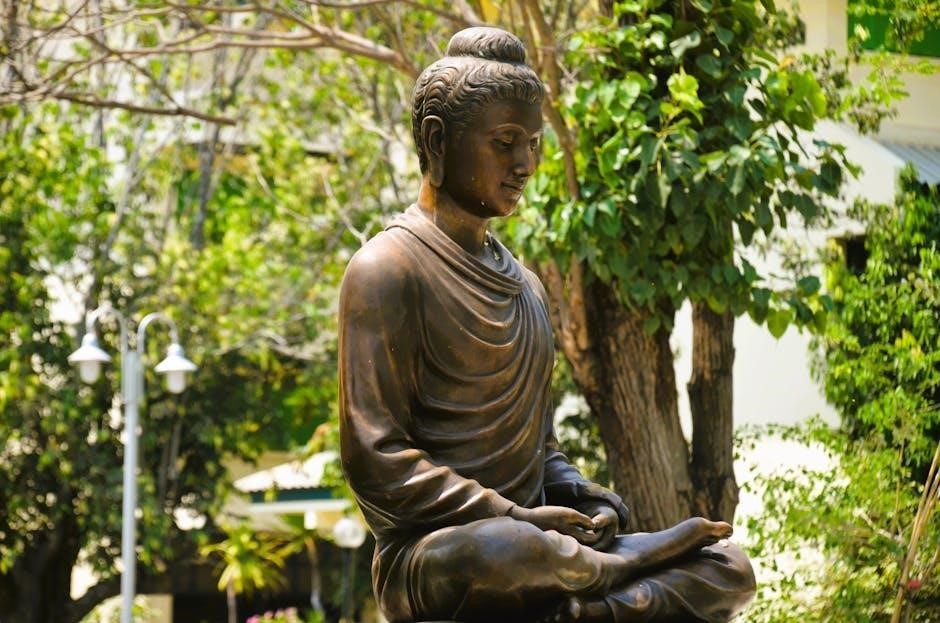Morihei Ueshiba’s The Art of Peace is a timeless guide blending martial arts with spiritual wisdom. It emphasizes harmony, non-violence, and self-improvement, offering universal truths for modern life.
1.1 Overview of Morihei Ueshiba and His Philosophy
Morihei Ueshiba (1883-1969) was a renowned Japanese martial artist and founder of Aikido, a discipline he termed “The Art of Peace.” His philosophy centered on harmony, non-violence, and spiritual growth, blending martial techniques with deep ethical and metaphysical insights. Inspired by Shinto and Zen Buddhism, Ueshiba believed that true power lies in compassion and balance. He advocated for resolving conflicts peacefully and cultivating inner peace, viewing Aikido as a path to self-improvement and global harmony. His teachings emphasize unity with nature and the divine, offering timeless wisdom for personal and societal transformation.
1.2 The Significance of the Book in Modern Times
The Art of Peace remains a timeless guide for modern life, offering wisdom on harmony, non-violence, and self-improvement. Its teachings transcend generations, addressing contemporary challenges like conflict resolution and environmental stewardship. The book’s availability in PDF format has widened its reach, making its principles accessible globally. Ueshiba’s emphasis on compassion and balance resonates in today’s fast-paced, often divided world, providing a blueprint for personal and societal transformation. Its digital accessibility ensures that Ueshiba’s vision of global harmony continues to inspire and guide individuals seeking peace and unity in their lives and communities.
Core Principles of the Art of Peace
The Art of Peace revolves around harmony, non-violence, and self-improvement. It teaches aligning with nature and resolving conflicts peacefully, offering universal principles for modern living and growth.
2.1 Harmony and Balance in Life
Hatred and anger only generate more hatred and anger. Ueshiba emphasizes that true strength lies in harmony and balance. By embracing non-violence and compassion, one can find inner peace and resolve conflicts without causing harm. This principle is central to Aikido, where the goal is not to defeat others but to restore equilibrium. In daily life, harmony involves aligning actions with nature and fostering mutual respect. Achieving this balance allows individuals to move through the world with grace and purpose, creating a ripple effect of peace in their surroundings.
2.2 The Role of Non-Violence and Compassion
Non-violence and compassion are cornerstone principles of The Art of Peace. Ueshiba teaches that true strength lies not in aggression but in understanding and harmonizing with others. Compassion allows us to see the humanity in adversaries, fostering resolution without conflict. This approach encourages empathy and mutual respect, transforming disputes into opportunities for growth. By embracing non-violence, individuals can create a ripple effect of peace, influencing those around them. The book emphasizes that compassion is not weakness but a powerful force that aligns with the divine and promotes harmony in all interactions.
2.3 The Connection Between Nature and Inner Peace
Morihei Ueshiba often emphasized the profound connection between nature and inner peace. He believed that nature reflects the divine creation and embodies harmony. Protecting and preserving the natural world is essential, as it mirrors our inner balance. By living in sync with nature, individuals can cultivate spiritual growth and achieve a deeper sense of peace. Ueshiba taught that nature’s beauty and rhythms guide us toward self-realization and equilibrium. This philosophy encourages a holistic approach to life, where harmony with the environment fosters inner tranquility and alignment with the universe.

The Art of Peace and Aikido
Aikido, founded by Morihei Ueshiba, is a martial art embodying the principles of harmony and non-violence. It serves as a pathway to spiritual growth and self-improvement.
3.1 The Martial Art as a Path to Spiritual Growth
Aikido, as taught by Morihei Ueshiba, is not merely a physical discipline but a profound path to spiritual growth. It combines flowing movements, meditation, and introspection to cultivate inner balance and harmony. Ueshiba emphasized that true mastery lies in understanding the connection between oneself and the universe, fostering compassion and wisdom. By practicing Aikido, one embarks on a journey of self-discovery and enlightenment, aligning with the principles of peace and non-violence. This holistic approach makes Aikido a unique bridge between martial technique and spiritual awakening, appealing to seekers of both physical and inner transformation.
3.2 Practical Applications of Aikido Principles
The principles of Aikido, as outlined in The Art of Peace, offer practical wisdom for everyday life. By embracing harmony and balance, individuals can navigate conflicts with grace and compassion. Aikido teaches the importance of redirecting energy rather than resisting it, a concept applicable to personal relationships, workplace challenges, and even global conflicts. Its emphasis on non-violence and cooperation provides a framework for resolving disputes peacefully. These teachings encourage individuals to cultivate inner calm and adaptability, transforming life’s difficulties into opportunities for growth and understanding. Ueshiba’s philosophy reminds us that true strength lies in unity and the wise use of energy.
The Art of Peace in Everyday Life
The Art of Peace teaches harmony and balance, guiding individuals to resolve conflicts peacefully and foster compassion in daily interactions, promoting inner peace and unity.
4.1 Applying the Teachings to Personal Relationships
Morihei Ueshiba’s teachings in The Art of Peace emphasize harmony and balance in personal relationships. By fostering empathy, understanding, and non-violent communication, individuals can resolve conflicts peacefully. The principles encourage active listening and compassion, fostering deeper connections. Ueshiba’s philosophy promotes mutual respect and the avoidance of hostility, aligning with the idea that true strength lies in gentleness. These teachings inspire individuals to approach relationships with patience and self-awareness, leading to more meaningful and harmonious interactions. By integrating these values, personal relationships become a reflection of inner peace and the pursuit of unity.
4.2 The Role of Self-Improvement and Inner Divinity
The Art of Peace emphasizes the importance of self-improvement and recognizing one’s inner divinity. Morihei Ueshiba taught that true peace begins within, requiring individuals to cultivate self-awareness, discipline, and introspection. By embracing inner growth, one aligns with the universe’s harmony, fostering a sense of purpose and fulfillment. Ueshiba’s philosophy encourages individuals to embody compassion, wisdom, and courage, reflecting their divine nature. This journey of self-improvement is not only a personal transformation but also a contribution to global harmony, as inner peace naturally extends outward, creating a ripple effect of positivity and unity in the world.

The Art of Peace and Global Harmony
The Art of Peace advocates for global harmony by fostering inner peace and unity. It teaches resolving conflicts through compassion and cooperation, promoting collective well-being worldwide.
5.1 Fostering Peace Between Nations
Morihei Ueshiba’s teachings emphasize that global harmony begins with individual peace. By cultivating compassion and understanding, nations can resolve conflicts non-violently, fostering mutual respect and cooperation. The principles of Aikido, such as harmony and balance, extend beyond personal growth to international relations, encouraging dialogue and empathy. Ueshiba believed that true strength lies in unity and the avoidance of discord. His philosophy inspires leaders to prioritize peace, recognizing that the well-being of one nation is intertwined with the well-being of all. This approach to diplomacy reflects the core of The Art of Peace, offering a path to a more harmonious world.
5.2 The Importance of Environmental Stewardship
Morihei Ueshiba’s philosophy underscores the sacred duty to protect Mother Nature, viewing it as a divine reflection of creation. Environmental stewardship is integral to the Art of Peace, emphasizing harmony with the natural world. Ueshiba taught that humanity must preserve the Earth’s beauty and freshness, as it is a source of balance and inner peace. By caring for nature, individuals foster a deeper connection to life’s interconnectedness, aligning with Aikido’s principles of harmony and balance. This practice not only sustains the planet but also nurtures global peace, reminding us that caring for the Earth is a collective responsibility.

The Art of Peace PDF and Its Availability
The Art of Peace PDF is widely available online, with platforms like Scribd offering free downloads. Its digital accessibility has boosted its global reach and popularity significantly.
6.1 Where to Find the PDF Version
The PDF version of The Art of Peace is readily available online. Scribd, a leading social reading platform, offers free access to the book. Users can download or view it directly at http://www.scribd.com. This digital version ensures global accessibility, making Morihei Ueshiba’s teachings easily reachable for readers worldwide.
6.2 The Impact of Digital Access on Its Popularity
The availability of The Art of Peace in PDF format has significantly boosted its popularity. Digital access allows global readers to easily download or view the book from platforms like Scribd. This convenience has attracted a broader audience, making Ueshiba’s teachings more accessible. The digital version has also facilitated sharing and discussions, further enhancing its reach. As a result, the book’s principles are being applied in various modern contexts, contributing to its enduring relevance and appeal in fostering peace and harmony worldwide.

The Art of Peace and Modern Society
The Art of Peace remains highly relevant in today’s fast-paced world, offering timeless wisdom for conflict resolution and environmental stewardship, inspiring global harmony and inner balance.
7.1 Relevance in the Digital Age
Morihei Ueshiba’s teachings in The Art of Peace remain profoundly relevant in today’s digital world. The book’s emphasis on harmony, balance, and non-violence offers a timeless guide for navigating modern challenges. In an era dominated by technology and instant connectivity, the principles of inner peace and compassion provide a counterbalance to the stresses of digital life. The availability of the PDF version ensures that Ueshiba’s wisdom is accessible to a global audience, inspiring individuals to cultivate mindfulness and resolve conflicts peacefully, even in online spaces. His philosophy continues to resonate, offering a path to serenity amidst the chaos of the digital age.
7.2 Using the Art of Peace for Conflict Resolution
Morihei Ueshiba’s teachings in The Art of Peace offer a powerful framework for resolving conflicts through non-violence and compassion. By emphasizing harmony and balance, the principles guide individuals to approach disputes with empathy and understanding. The PDF version of the book highlights Ueshiba’s belief that true victory lies in resolving conflicts peacefully, without causing harm. His philosophy encourages aligning with nature’s rhythms and embracing inner peace to foster mutual respect and cooperation. These timeless strategies provide practical tools for mediating disagreements in personal and professional settings, promoting resolution that honors all parties involved and upholds the greater good.